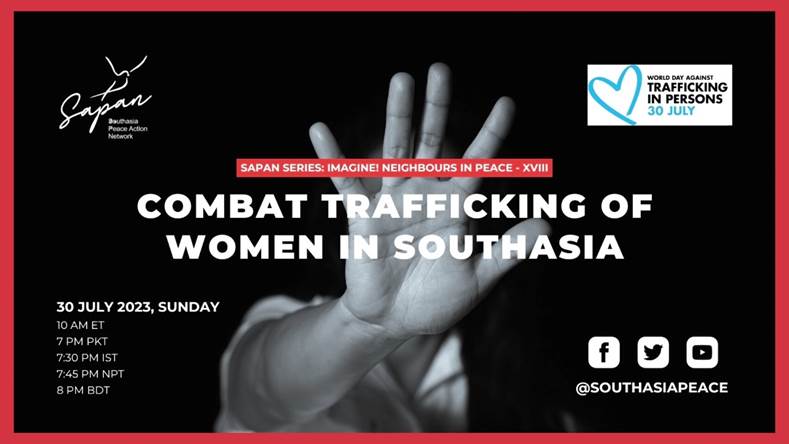

Call for Combating Trafficking of Women and Girls in South Asia
By Sapan News Desk
“Human trafficking is caused by the intersection of sexism and poverty,” observes Ruchira Gupta, author of the recently released I Kick and I Fly and founder of the survivor organization Apne Aap.
As she points out, it is the most vulnerable and marginalized who are most likely to be preyed on because they are poor, are female and are from marginalized ethnicities, castes, tribes and religious communities.
Gupta was speaking at a webinar last Sunday organized by Sapan, the Southasia Peace Action Network titled ‘Combat the Trafficking of Women in Southasia’, to mark UN World Day Against Trafficking in Persons. This was the 18th in the Sapan series titled 'Imagine! Neighbors in Peace', held on the last Sunday of most months since Sapan launch in March 2021.
These vulnerabilities need to be addressed through greater investment in education, health, food, clothing and shelter, but it is as important to combat the culture of impunity for offenders, agreed the panelists.
Joining from Dhaka, Sigma Huda, the first UN Special Rapporteur on Trafficking in Persons, offered initial comments, noting that while the SAARC countries signed the Convention on Preventing and Combating Trafficking in Women and Children for Prostitution in 2002, implementation has been extremely disappointing.
“Women and children continue to fall prey to international prostitution networks,” she said, noting that the member states still function as countries of origin, transit, and destination. Meanwhile, the repatriation and rehabilitation of victims falls short of the outcomes envisaged by the Convention, even though laws enacted in these countries mirror the articles of the Convention.
“Since most countries are both sources, transits and destinations, there has to be greater cooperation among the countries in the region,” she stressed.
Mehr Husain, news editor of The Friday Times, Pakistan, and a sustainable practices advocate, agreed. Pakistan too has not honored or enforced constitutional provisions. She drew a distinction between the smuggling and trafficking of persons, noting that women are first smuggled human labor then sexually exploited.
Prostitution is often and mistakenly taken to be voluntary, but the crucial point is that the traffickers remove the option of leaving by seizing their passports, ID cards and other documents, effectively eliminating all other options for survival, she noted.
Responding to a question from a participant from Quetta about whether a religious factor also plays into the hands of the traffickers, she agreed that while in certain societies there is a perception that men are entitled to prey upon a woman working at home or office, the problem is also located within a patriarchal frame.
“Religion can function as a policing tool regarding the ownership of the woman, the woman’s body,” she added.
Sabin Shrestha, Executive Director, Forum for Women, Law and Development, Kathmandu, who helped draft the Human Trafficking and Transportation (Control) Act and Regulation in Nepal, said that a key feature of this piece of legislation was ‘the certification of the statement of the survivor.’
He explained that human trafficking is a well organized crime involving highly influential people ’which makes victims very reluctant to appear in court.’
‘Now the burden of proof is on the perpetrator or accused; the survivor’s statement, certified by the court, stands.’
The very fact that no less than 49 million people, the vast majority of whom are women and girls, are victims of trafficking demonstrates the alarming scale of the problem, emphasized Sharli Mudaliyar, a doctoral scholar at the Tata Institute of Social Sciences (TISS), Mumbai, India in her concluding remarks.
While advocating and insisting on combating the issue of impunity, Gupta said she was also wary of giving blanket permission to the police, given the often-fascistic nature of the state and the existence of toxic masculinity.
“We need to look out for ‘the last girl’, who is the 13-year-old in a brothel in Calcutta or a 19-year-old in a street corner who is poor, from an oppressed caste and is extremely vulnerable, looking to survive and therefore likely to be targeted by someone who offers her a job,” said Gupta.
Well-known women’s rights activist Khawar Mumtaz in Lahore hosted the webinar, while prominent Sri Lankan journalist and poet Malinda Seneviratne moderated the panel discussion.
At the end of the webinar, participants endorsed a resolution proposed by Sapan titled ‘ Combat the Trafficking of Women and Girls in Southasia ’, proposing a Southasian Tribunal to combat trafficking of women and girls.
The resolution incorporated the ideas, concerns and proposals expressed by journalists, academics, activists and other stakeholders during the webinar, especially those of the panelists.

